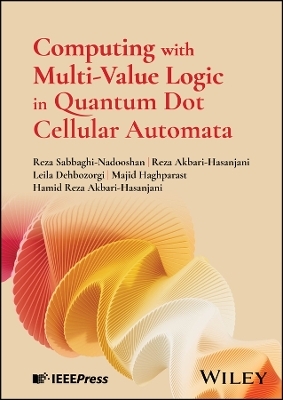
Computing with Multi-Value Logic in Quantum Dot Cellular Automata
Wiley-IEEE Press (Verlag)
978-1-394-25394-4 (ISBN)
Miniaturization is one of the major forms (and drivers) of innovation in electronics and computing. In recent years, the rapid reduction in the size of semiconductors and other key elements of digital technology has created major challenges, which new technologies are being continuously mobilized to meet. Quantum dot cellular automata (QCA) is a technology with huge potential to meet these challenges, particularly if multi-value computing is brought to bear.
Computing with Multi-Value Logic in Quantum Dot Cellular Automata introduces this groundbreaking area of technology and its major applications. Using MATLAB® software and a novel multi-value logic simulator, the book demonstrates that multi-value circuits with a function that approximates fuzzy logic are within reach of modern engineering and design. Rigorous and clear, this book offers a crucial introduction to the processes of designing multi-value logic circuits with QCA technology.
Readers will also find:
The tools required to design fuzzy-quantum controllers with high processing speed
Detailed discussion of topics including basic gate function, the energy consumption of QCA multi-value cells, and much more
Extensive MATLAB® data and other worked-through examples
Computing with Multi-Value Logic in Quantum Dot Cellular Automata is ideal for researchers and readers who are looking for an explanation of the basic concepts required to design multi-value circuits in this field.
Reza Sabbaghi-Nadooshan, PhD, is a Professor with the Department of Electrical Engineering, Central Tehran Branch, Islamic Azad University, Tehran, Iran. Reza Akbari-Hasanjani, PhD, is with the Department of Electrical Engineering, Central Tehran Branch, Islamic Azad University, Tehran, Iran. Leila Dehbozorgi is with the Department of Electrical Engineering, Central Tehran Branch, Islamic Azad University, Tehran, Iran. Majid Haghparast is affiliated with the Faculty of Information Technology at the University of Jyväskylä, Jyväskylä, Finland. Hamid Reza Akbari-Hasanjani, PhD, is with the School of Chemistry, Damghan University, Damghan, Iran.
List of Figures xi
List of Tables xvii
About the Authors xxi
Preface xxiii
Introduction xxv
1 Quantum Dots 1
1.1 Introduction to Quantum Dots 1
1.2 Physical Characteristics of Semiconductor Quantum Dots 2
1.3 Quantum Dots Structure 3
1.4 Surface Structure of Quantum Dots 7
1.5 Properties of Quantum Dots 10
2 Synthesis Methods of Quantum Dots and Applications 15
2.1 Synthesis Processes 15
2.2 Top-Down Synthesis Processes 15
2.3 Bottom-Up Synthesis Processes 17
2.4 Applications of Quantum Dots 19
3 Overview of QCA 23
3.1 Introduction to QCA Technology 23
3.2 Binary QCA Concept 24
3.3 Ternary QCA Cell Structure 24
3.4 Clock in QCA Technology 25
3.5 Manufacturing and Implementation of QCA 26
3.6 Overview of Quantum Gates 26
4 Polarization and Polarization Calculations in QCA (Quantum Calculations in QCA) 33
4.1 Introduction 33
4.2 Polarization and Calculation of Hamiltonian Matrix in QCA 33
5 Multi-Valued Cells Based on Polarization Calculations 59
5.1 Ternary QCA 59
5.2 Quaternary QCA 62
5.3 Quinary QCA 72
5.4 Hypothesis Based on n-Value QCA Cell 82
5.5 Fuzzy Logic Design Using MIN and MAX Functions 84
5.6 Quantum Information 87
6 Effect of Polarization for Two Adjacent Cells and Power Consumption in Multi-Valued Cells 91
6.1 Effect of Two Adjacent Cells in Terms of Polarization 91
6.2 Power Consumption in QCA Technology 95
7 Structure of Basic Gates Using the Proposed Cells in Multi-Value QCA 101
7.1 Structure of Basic Gates Using TQCA 101
7.2 Structure of Basic QQCA Gates 105
7.3 Structure of Basic Gates Using QuQCA 111
8 Implementation of Ternary and Quaternary Basic Gates Using QQCASim and TQCASim 119
8.1 TQCA Simulator 120
8.2 QQCA Simulator for QQCA Circuit Simulation 125
9 A Review of Literature on Memory Structures 135
9.1 Introduction 135
9.2 A Review of Basic Memory Structures 136
9.3 Review of Literature on Memory Design 138
10 Proposed PIM Cells and Their Fault Analysis in Binary QCA 141
10.1 Introduction 141
10.2 Binary QCA-Based Structures 143
10.3 Fault Analysis 147
11 Design Details of Binary Boolean Operators Using Basic PIM Cells: Proposing and Analyzing Basic-Extended Hypothesis 157
11.1 Introduction 157
11.2 Basic-Extended Hypothesis 157
11.3 Designing Logic Gates with Binary QCA-Based PIM Capability 157
12 Proposed PIM Cells in Ternary QCA and Their Fault Analysis 173
12.1 Introduction 173
12.2 Simulation of a Flip-Flop in Ternary QCA Using MATLAB 173
12.3 Structures in Ternary QCA 174
12.4 Fault Analysis 181
13 Design Details of Ternary Boolean Operators Using Basic PIM Cells and Analysis of Basic-Extended Hypothesis 189
13.1 Introduction 189
13.2 Designing Logic Gates With Ternary QCA-Based PIM Capability 189
13.3 Evaluation, Analysis, and Comparison of Results 196
14 Conclusions and Suggestions 201
14.1 Introduction 201
14.2 Summary and Conclusion 201
14.3 Suggestions 203
References 205
A Matrices217
A.1 Particle State Matrix in QQCA 217
A.2 Particle State Matrix in QQCA 218
B Electrostatic Energy Calculation 223
Index 237
| Erscheinungsdatum | 21.08.2024 |
|---|---|
| Sprache | englisch |
| Gewicht | 1107 g |
| Themenwelt | Mathematik / Informatik ► Informatik ► Theorie / Studium |
| Technik ► Elektrotechnik / Energietechnik | |
| ISBN-10 | 1-394-25394-X / 139425394X |
| ISBN-13 | 978-1-394-25394-4 / 9781394253944 |
| Zustand | Neuware |
| Haben Sie eine Frage zum Produkt? |
aus dem Bereich


